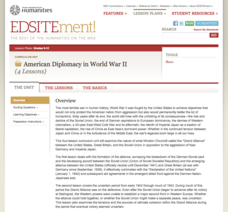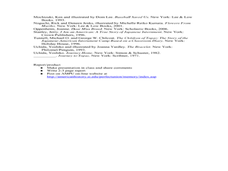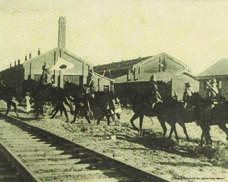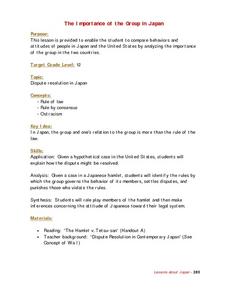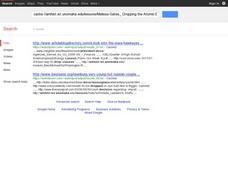National Endowment for the Humanities
How "Grand" and "Allied" Was the Grand Alliance?
Learn more about the Grand Alliance with a scaffolded lesson plan that includes four activities. Class members use primary sources to complete a map exercise, understand the goals and objectives of each individual nation, and participate...
National WWII Museum
Strategic Decision Making in the Pacific Scenarios
Individuals decide what they would do when faced with a difficult military decision that puts others' safety in jeopardy. The lesson also gives the real-life outcomes of the scenarios that occurred during World War II to give them a...
National Endowment for the Humanities
American Diplocmacy in World War II
The end of World War II saw the world deeply changed over the last few years. Four thorough lessons explore post-war Europe, America, and Asia through reading assignments and discussion questions about the Grand Alliance and the signing...
Foreign Policy Research Institute
A Geography Lesson
Fewer and fewer people have a strong grasp of world geography, but this activity helps students understand geopolitics by creating their own original historical map. The activity requires selecting a country from the list provided,...
Curated OER
The Declaration of War Against Japan and Just War Theory
High schoolers examine the attack on Pearl Harbor and how it changed the history of the United States. After watching a video from "The War", they discuss the characteristics of a "just war" and identify the laws in international...
Smithsonian Institution
Mobilizing Children
Scholars find out how the government used propaganda to mobilize children to help in the war effort. Lesson exercises include analyzing a quote from Franklin Roosevelt, viewing propaganda images and posters, and participating in a lively...
Curated OER
Impact of the End of World War II on Japan
Ninth graders examine and discuss reasons United States occupied Japan after surrender in World War II, view photographs of Japan at end of War and explore how U.S. occupation affected Japan's political, economic, and social systems, and...
Curated OER
Lesson III: Crisis, Pearl Harbor, Internment
The third in a series of lessons introduced by “A Fence Away From Freedom,” uses the Smithsonian website, “A More Perfect Union: Japanese Americans and the U.S. Constitution” and focuses on the section of the presentation devoted to the...
Curated OER
Tejana Military Members in World War II
Seventh graders discover who the Tejanas were and how they contributed to World War II. In this World War II lesson, 7th graders listen to their instructor discuss who the Tejanas were prior to researching the contributions of three of...
National WWII Museum
Picturing the War in the Pacific Photos, Datelines and Captions
Young historians have the opportunity to see photos from the war in the Pacific and learn more about what each photo represents. Scholars use their knowledge of WWII to match dates and descriptions to real-life photos from the war. The...
Rutgers University
How the Allies Won World War II: Island-hopping in the Central Pacific
Using primary source documents, young historians explore the strategies the US used to defeat Japan during WWII. They also learn about the American military experience, and innovations that changed the style of warfare. Students benefit...
Curated OER
Peace
Ninth graders explore through research changes in Japan following A-bomb, discuss how people of all ages can model tolerance and peaceful coexistence, examine Constitution of Japan, and identify its three basic tenants.
Curated OER
The failure of Diplomacy, September-December 1941
Students investigate four main issues of concern between US and Japan prior to US involvement in World War II. In this role play lesson, students will take the role of US and Japanese negotiators trying to find a diplomatic solution to...
Curated OER
The End of United States' Occupation of Japan
Ninth graders examine and discuss reasons for end of U.S. occupation of Japan in 1952, locate surrounding Asian countries on map, explore changes to Japan after World War II, and discuss how changes in Japan impacted other countries.
Curated OER
Radioactive: An Interdisciplinary Study of Marie and Pierre Curie
Use this innovative text to show the far-reaching influence of the dynamic Curie couple
Curated OER
The Importance of the Group in Japan
Twelfth graders discuss the importance of the group in Japan. In groups, they compare and contrast behaviors and attitudes of those in Japan and the United States. They are given a case to review and identify the rules by which the...
Curated OER
Horse Warriors
Students compare the Roman Empire, medieval Europe and feudal Japan. In this warrior societies lesson, students research the 3 warrior societies and share their research findings with their classmates.
Curated OER
Dropping the Atomic Bomb The Decision That Defined a Presidency.
Students examine historical evidence regarding the atomic bomb. In this Truman presidency lesson, students research images and documents about the use of the bomb in Japan. Students write position papers that identify their stance on the...
National Endowment for the Humanities
The New Order for "Greater East Asia"
Sometimes the New Order becomes synonymous with its implications for European countries, but what about its consequences for East Asia? The final instructional activity in a four-part series teaches scholars about World War II. High...
Scholastic
Dear Miss Breed
This compelling plan based on the letters in the book Dear Miss Breed engages readers in learning what it was like for Japanese Americans following the attacks at Pearl Harbor. After reading the letters, young scholars will partake in...
Stanford University
Gulf of Tonkin Resolution
Learners read, discuss, and view a Powerpoint on the Gulf of Tonkin Resolution. In this Gulf of Tonkin Resolution lesson plan, students research the resolution and then answer short answer questions about it.
Curated OER
Bridging History and Technology
Learners study the history and importance of the Triborough Bridge in New York City, and then research different bridges and prepare presentations about them. They, in groups, research a bridge and prepare a poster about it.
Curated OER
Imposing Democracy
Twelfth graders discuss the probability of imposing a democracy in a country in which there is no history of this type of government being successful. Using the internet, they work together to research Japan's experience with democracy...
Curated OER
Japan Writing Activity
Seventh graders explore the current tensions in Asia by completing a graphic organizer. In this Asian politics lesson, 7th graders examine a Powerpoint slide and news article which gives them the information needed to fill in their...




